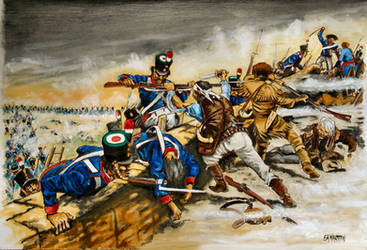Deviation Actions
Description
Next Page : dinosaurusgede.deviantart.com/…
Previous Page : dinosaurusgede.deviantart.com/…
The above story is greatly inspired by Lord Laon and the Seven-Headed Dragon (The Legend of Mount Kanlaon) : sugarcain88.tumblr.com/post/37…
Inspired by this post, which contests the notion that Western colonialism has ‘helped’ the Philippines. Also worth reading is this
-------------------------------------------------------------------------------------------------------------
The Dragon : The Symbol of Good in Asia & The Symbol of Evil in West
In many Asian cultures dragons were, and in some cultures still are, revered as representative of the primal forces of nature, religion and the universe. They are associated with wisdom—often said to be wiser than humans—and longevity. They are commonly said to possess some form of magic or other supernatural power, and are often associated with wells, rain, and rivers. In some cultures, they are also said to be capable ofhuman speech. In some traditions dragons are said to have taught humans to talk.
In Western culture, the dragon represents evil and darkness. Unlike the celestial image of the Eastern dragon, the Western dragon has sharp teeth and strong legs. It is said to bring harm, suffering, and fear to human beings.
Source :
www.theepochtimes.com/n3/14897…
www.abovetopsecret.com/forum/t…
Uncovering Philippines Precolonial Past
Yet another problem with current Philippine history education is the complete disregard for Philippines’ pre-colonial past. There’s a brief description of the 1521 Battle of Mactan, where Magellan was defeated by the first ‘Filipino’ (put in quotation marks as technically there was no such concept at the time) hero Lapu-Lapu, then Legaspi’s ‘founding’ the Philippines 50 years later, paving the way for colonialism in the country, but that’s about it. There is little to no mention of the culture of the Philippine islands before that. When Magellan set foot on the Philippines, he didn’t find brute incoherent, half-naked savages who used stone tools and took to jungles to shelter. In fact, Magellan’s men were astounded by the extravagances of the islands’ chieftains. Carmen Guerrero Nakpil noted in her book, Heroes and Villains, that pre-colonial Filipinos “practically had silver pouring out of their ears.” In the same book, it is explained the actual situation was:
“Filipinos had never seen white men before Magellan and never thought the strangers would be as rapacious and predatory as they would prove to be. They assumed the new foreigners to be poor and needy because they had only glass beads, a string of little bells and a red cap (Magellan’s gifts) to reciprocate the native prodigality. The white men were, in fact, so dazzled by the earrings, chains, armlets and anklets of pure gold, worn by both the native men and women…
“At the time, our land, this archipelago, consisted of thousands of islands with pristine, enchanting ecosystems. Our people lived along white beaches, the banks of crystalline rivers and magical lakes where they fished; farmed the rice fields and orchards between the peaks of the Cordilleras, majestic waterfalls and volcanoes; they hunted, dug for gold, wove cloth from plants and grasses, sang and danced, swam and feasted.
“They were loosely organized into small fiefdoms, ruled by occasionally-warring chieftains attended by household serfs and slave workers and warriors… Their women were priestesses and rulers, with a degree of sexual freedom that would have made the X and Y-Generations blush.”
Not only did our people already have a writing system, Baybayin, in pre-colonial times, but they also had established political organization, social stratification, religion, and a culture deeply attuned into the arts as well as weapon-building. Our people were well-known sea-farers and had very good standing in business and trading with the Chinese empire (then the most powerful nation in the world), as well as with our fellow southeast Asians. The Luzones, natives of the island of Luzon, were fierce warriors, traders, investors, mercenaries, and sea-fares. It took two attempts for Legaspi’s men to completely contract Maynila from the Luzones, and their victory was attributed only to recent developments in firepower technology of the Spaniards.
Read more :
henantonioluna.tumblr.com/post…
www.heritage-history.com/?c=re…
Nagaraja belongs to ![]()





















![The War to End All Wars [Hetalia]](https://images-wixmp-ed30a86b8c4ca887773594c2.wixmp.com/f/c113a702-da34-4928-89b9-4bdf849a50a2/d522hwg-eca46641-ecd7-4d19-be97-adce15b79bac.jpg/v1/crop/w_184)











